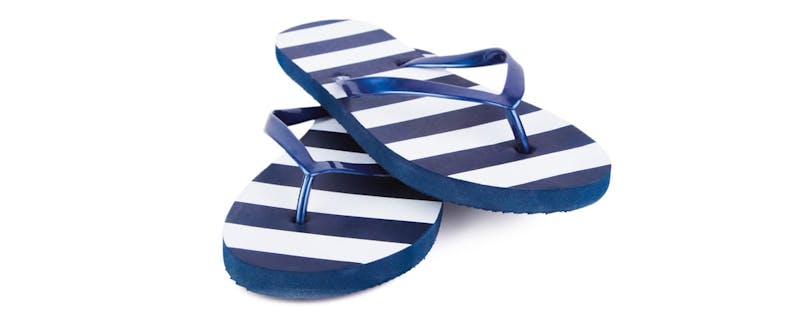Schedule a Consultation
Contact Us


While freeing your feet from the confines of restrictive footwear has its benefits, it also has a downside that may not show for years to come.
Flip flops do offer some protection for the bottom of your feet, depending upon their thickness. They are good for protecting your feet from sharp shells on the beach or hot pavement in parking lots. They can also protect you in public showers from bacterial and fungal infections such as athlete’s foot. Since they don’t squeeze your feet, they allow your bones to assume a more natural, barefoot position, which is preferable to pointed-toe heels any day. However, there are a few cons to wearing these comfy shoes that have to be considered.
Lack of Support
While you can find flip flops that provide arch support, the flat type offers no support to your foot at all. If you have flat feet or a high arch, this can cause undue stress on the bones in your upper foot, resulting in pain and inflammation. Sprained ankles are a common injury caused by the lack of support.
Lack of Protection
Even if your flip flops are sturdy and support your arches, they do not offer any protection for the top of your feet or your toes. Typical injuries include ripped off toenails and broken toes from banging into objects, cuts and abrasions from glass or other sharp objects, and broken or bruised bones from dropping something on the top of your foot.
Long-Term Bone and Tendon Damage
Flip flops are not made for wearing all day long. The lack of support during long-term wear can put your joints into abnormal positions, causing damage to the bones and tendons that may not show up right away. For example, if you have a high arch, your foot may pronate inward, causing your ankle, knee and hip joints to become misaligned. You will wonder why your hips and knees hurt, when it is really all about your feet. Another problem is that flip-flops cause your feet to overcompensate by gripping with your toes as your walk, which can cause a condition known as hammertoe.
Wear your flip flops in the shower, on the beach or short-term, and always look for those that provide arch support. To avoid injury and joint damage, do not wear them in dangerous places, for sports or long-term.